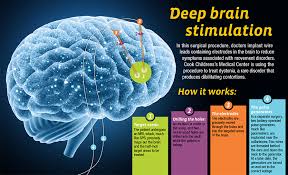Deep brain stimulation (DBS) is a therapy. The majority of people receiving deep brain stimulation live with a diagnosis of Parkinson’s disease (PD). This technique helpful for motivating convulsion, interrupted fluctuations, dyskinesia. One of the main limitations of deep brain stimulation has been that it requires brain surgery and carries an associated risk of hemorrhage, stroke, infection, and hardware failure. Transcranial magnetic stimulation (TMS) and transcranial direct-current stimulation (tDCS) have been recently utilized as less robust alternatives however these therapies have been largely limited to being applied to the brain’s surface and coverings. a deep brain stimulation technique that is not surgery and it can reach deep into the brain.
How Does Deep Brain Stimulation For Depression Work?
Temporal interference (TI). In this technique pass the multiple currents to the brain at high frequencies. The high-frequency method is used to preserve the superficial stimulation of brain cells. By introducing two current sources at different timing and frequencies from outside the brain, the interference between the two separated electrical fields can be used to create a cover. The cover between the currents would assume a frequency that was the difference between the two current sources. The location of the TI envelope can be adjusted and aimed at specific brain structures. To promote the method, MIT-based team stimulated the brains of awake and behaving mice and specifically directed current at the hippocampus (memory storage). The results revealed that modulate brain cells in the hippocampus without affecting the superficial brain cells above.
Will the currents delivered be capable of providing the high frequencies necessary to treat many of the most disabling Parkinson’s disease symptoms like depression, tremor, rigidity, bradykinesia, and this therapy is defensive and no unacceptable side effects?
Journal Name: Journal of Parkinsons Disease and Alzheimers Disease

